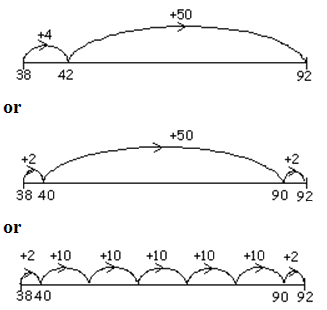Number line addition II
This task is about showing how to solve addition equations on a number line.

For the questions below show how to solve the equations on the number line. Read the example below before you start.
|
|
a)
|
Show how to solve the equation: 23 +
 = 80 on the number line below = 80 on the number line below |
 |
|
| b) |
Show how to solve the equation: 38 +  = 92 on the number line below. = 92 on the number line below. |
 |
|
| c) |
Show how to solve the equation: 127 +  = 253 on the number line below. = 253 on the number line below. |
 |


 = 70,
= 70,




 = 71, and for using place-value partitioning: refer to Problems like 37 +
= 71, and for using place-value partitioning: refer to Problems like 37 +